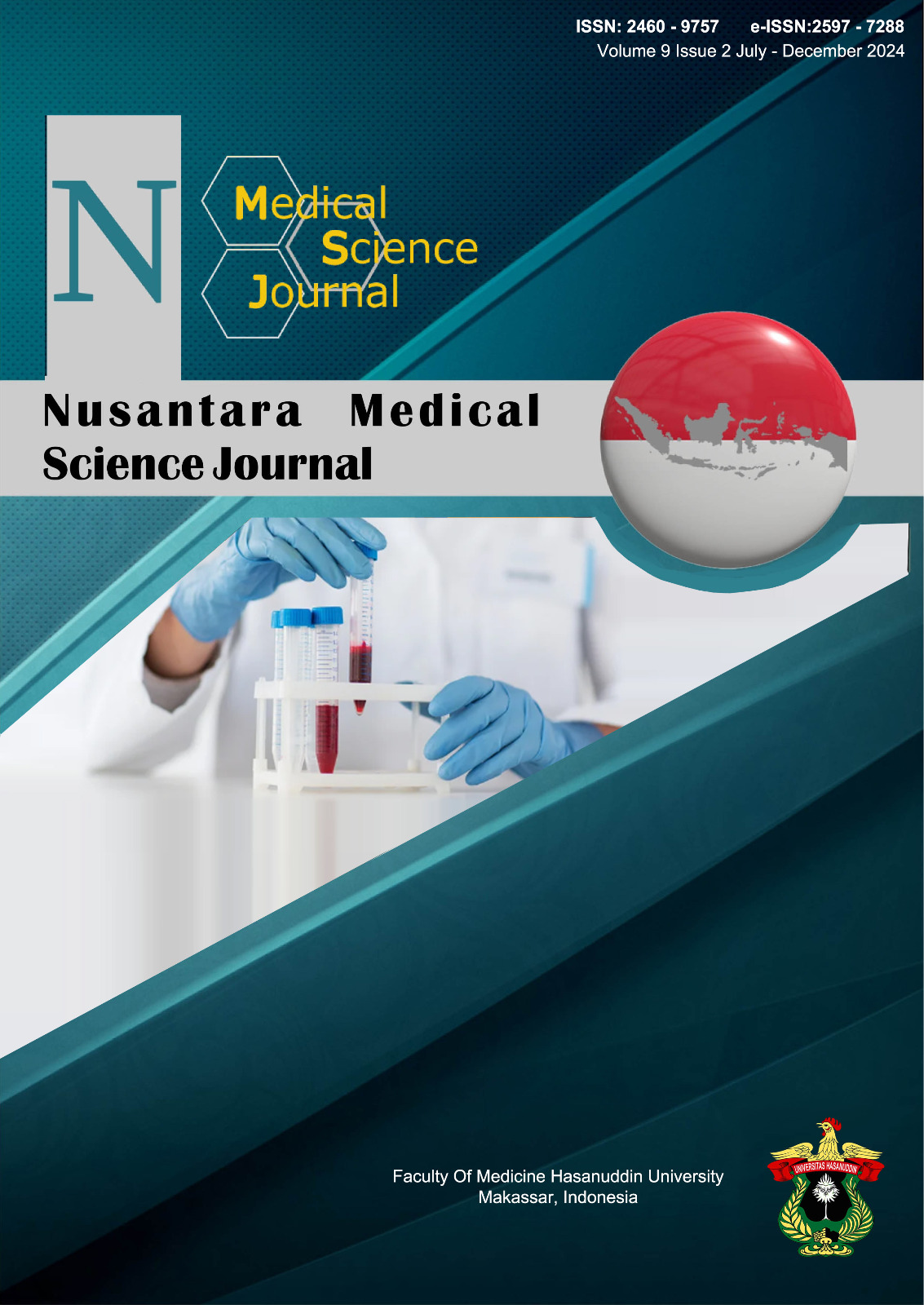Potential of Cat’s Whisker (Orthosiphon stamineus B) As Antidiabetic in Traditional Medicine of The Dayak Tribe in West Kalimantan : A Literature Review
Abstract
Introduction: Diabetes mellitus or better known as diabetes is a disease characterized by the body's inability to produce insulin or the inability to use insulin (insulin resistance). The high prevalence of diabetes sufferers in Indonesia requires attention and treatment, especially through medication. One of Indonesia's advantages compared to other countries is the biodiversity and cultural diversity sector in Indonesia, namely medicinal plants. The cat's whisker plant (Orthosiphon stamineus B) can be an alternative treatment for treating complications of diabetes mellitus. Cat's whisker leaves contain orthosiphon glucose, saponins, essential oils, flavonoids, polyphenols, potassium salts and myoinositol, several substances contained in this plant have the potential to lower blood sugar levels. Methods: This writing is a literature review by collecting literature from English and Indonesian language articles from 2014-2024, most of which are research articles. Results: The search using the keywords, resulting in a final total of 5 articles to be included in the literature review. Conclusion: This research reveals that cat's whiskers (Orthosiphon stamineus B) show potential as an effective antidiabetic agent. Treatment with Orthosiphon stamineus B extract significantly reduced blood glucose levels, increased insulin secretion, and increased ghrelin and GLP-1 levels, all of which contribute to glucose regulation
References
1. Gholamhoseinian A, Fallah H, Sharifi-Far F, Mirtajaddini M. The Inhibitory Effect of Some Iranian Plants Extracts on the Alpha Glucosidase. Iran J Basic Med Sci [Internet]. 2008 Jan 1 [cited 2024 Sep 1];11(1):1–9. Available from: https://ijbms.mums.ac.ir/article_5190.html
2. Ozougwu O. The pathogenesis and pathophysiology of type 1 and type 2 diabetes mellitus. Journal of Physiology and Pathophysiology. 2013 Sep 30;4(4):46–57.
3. Anani S. Hubungan antara perilaku pengendalian diabetes dan kadar glukosa darah pasien rawat jalan diabetes melitus (studi kasus di RSUD Arjawinangun Kabupaten Cirebon). Jurnal Kesehatan Masyarakat Universitas Diponegoro. 2012;1(2):18753..
4. Leonita E, Muliani A. Penggunaan obat tradisional oleh penderita diabetes mellitus dan faktor-faktor yang berhubungan di wilayah kerja Puskesmas Rejosari Pekanbaru Tahun 2015. Jurnal kesehatan komunitas (Journal of community health). 2015 Nov 1;3(1):47-52.
5. Harmida H, Sarno S, Yuni VF. Studi etnofitomedika di desa Lawang agung kecamatan Mulak ulu kabupaten Lahat Sumatera Selatan. Jurnal Penelitian Sains. 2011 Jan 15;14(1).
6. Dewoto HR. Pengembangan obat tradisional Indonesia menjadi fitofarmaka. Majalah kedokteran indonesia. 2007 Jul;57(7):205-11.
7. Tria A, Sumekar DW. Orthosiphon stamineus sebagai Terapi Herbal Diabetes Melitus. Medical Journal of Lampung University. 2016 Oct 2;5(3):28-32.
8. Mohamed EA, Siddiqui MJ, Ang LF, Sadikun A, Chan SH, Tan SC, Asmawi MZ, Yam MF. Potent α-glucosidase and α-amylase inhibitory activities of standardized 50% ethanolic extracts and sinensetin from Orthosiphon stamineus Benth as anti-diabetic mechanism. BMC complementary and alternative medicine. 2012 Dec;12:1-7.
9. Rao NK, Bethala K, Sisinthy SP, Rajeswari KS. Antidiabetic activity of Orthosiphon stamineus benth roots in streptozotocin induced type 2 diabetic rats. Asian Journal of Pharmaceutical and Clinical Research. 2014 Jan 1:149-53.
10. Lee HJ, Choi YJ, Park SY, Kim JY, Won KC, Son JK, Kim YW. Hexane extract of Orthosiphon stamineus induces insulin expression and prevents glucotoxicity in INS-1 cells. Diabetes & Metabolism Journal. 2015 Feb 1;39(1):51-8.
11. Masrif, M. and Ibrahim, I.R.O., 2015. Pengaruh Pemberian Ekstrak Daun Kumis Kucing (Orthosiphon Aristatus) Terhadap Perubahan Kadar Glukos Darah Pada Pasien Diabetes Mellitus Di Ruang Rawat Jalan Rumah Sakit Umum Bahteramas Provinsi Sulawesi Tenggara. Health Information: Jurnal Penelitian, pp.27-33.
12. Lokman EF, Saparuddin F, Muhammad H, Omar MH, Zulkapli A. Orthosiphon stamineus as a potential antidiabetic drug in maternal hyperglycemia in streptozotocin-induced diabetic rats. Integrative Medicine Research. 2019 Sep 1;8(3):173-9.Rao NK, Bethala K, Sisinthy SP, Rajeswari KS. Antidiabetic activity of Orthosiphon stamineus benth roots in streptozotocin induced type 2 diabetic rats. Asian Journal of Pharmaceutical and Clinical Research. 2014 Jan 1:149-53.
13. Bassalat N, Kadan S, Melamed S, Yaron T, Tietel Z, Karam D, Kmail A, Masalha M, Zaid H. In Vivo and In Vitro Antidiabetic Efficacy of Aqueous and Methanolic Extracts of Orthosiphon Stamineus Benth. Pharmaceutics. 2023 Mar 14;15(3):945.
14. Endokrinologi Indonesia Pedoman Pengelolaan Dan Pencegahan Diabetes Melitus Tipe P. Pedoman Pengelolaan Dan Pencegahan Diabetes Melitus Tipe 2 Dewasa Di Indonesia. 2021 Perkeni I Penerbit Pb. Perkeni.
15. Kalusalingam A, Hasnu DN, Khan A, Tan CS, Menon B, Narayanan V, Goh KW, Ikmal AM, Talip N, Subramanian P, Ming LC. An Updated Review of Ethnobotany, Ethnopharmacology, Phytochemistry and Pharmacological Activities of Orthosiphon stamineus Benth. Malaysian Applied Biology. 2024 Mar 31;53(1):1-8.
16. Febjislami S, Kurniawati AN, Melati M, Wahyu Y. Morphological characters, flowering and seed germination of the Indonesian medicinal plant Orthosiphon aristatus. Biodiversitas Journal of Biological Diversity. 2019 Jan 21;20(2):328-37.
17. Silalahi M. Orthosiphon stamineus Benth (uses and bioactivities). Indonesian Journal of Science and Education. 2019;3(1):26-33.
18. Mohamed EA, Yam MF, Ang LF, Mohamed AJ, Asmawi MZ. Antidiabetic properties and mechanism of action of Orthosiphon stamineus Benth bioactive sub-fraction in streptozotocin-induced diabetic rats. J Acupunct Meridian Stud 2013;6:31-40.
19. Purwati NI, Kartika Untari E, Susanti R. Studi Literatur Penggunaan Obat Tradisional Di Kalimantan Barat. J Mhs Farm Fak Kedokt Untan. 2017;
20. Andari D, Linda R, Rafdinal R. Pemanfaatan tumbuhan obat oleh masyarakat suku dayak kendawangan di Desa Rangkung Kecamatan Marau Kabupaten Ketapang. Protobiont. 2020;9(1).
Downloads
Published
How to Cite
Issue
Section
License
Copyright (c) 2025 Galih Abisatya Hartono Putra, Sari Andayani, Dianelita Asyifa Qisthi, Candra Aurelion, Taufiq Mochammad, Mistika Zakiah, Syarifah Nurul Yanti Rizki Syahab Assegaf

This work is licensed under a Creative Commons Attribution 4.0 International License.









